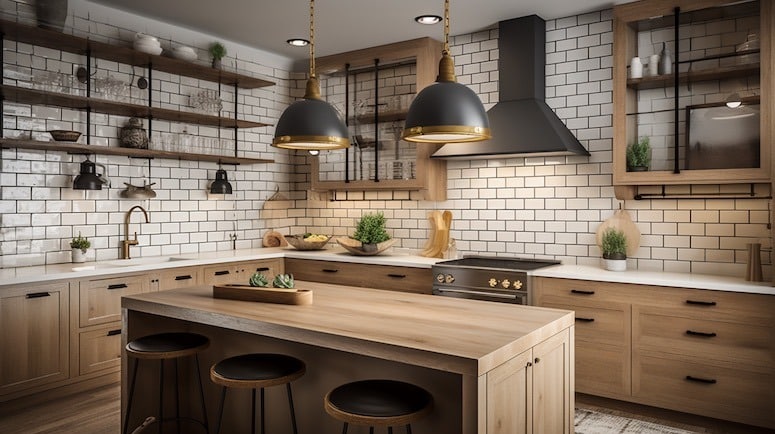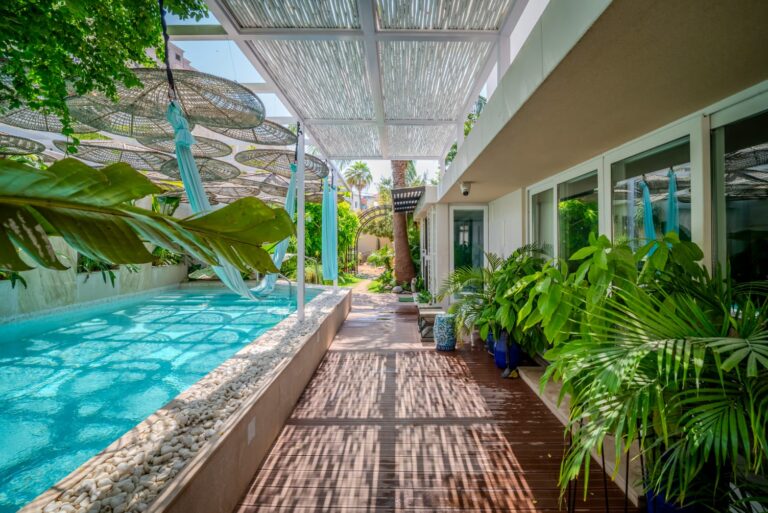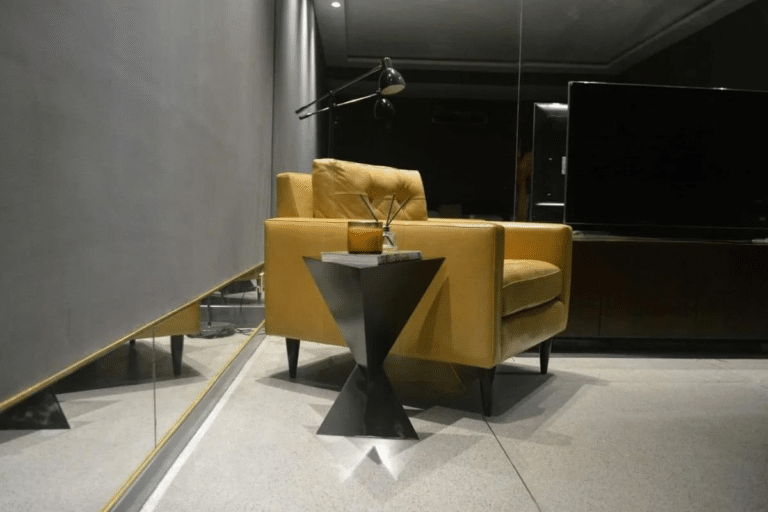Step into a world of clean lines, pops of color, and a celebration of functionality. Mid-century modern architecture and interior design, a movement that boomed in the years following World War II (roughly 1945-1970), isn’t just about nostalgia. It’s a design philosophy that influences how we construct and design our homes today.
A Post-War Revolution in Architecture and Interior Design
The world was a changed place after the devastation of World War II. People wanted to begin with a new way of living. This spirit of optimism and innovation spilled over into the design world. Mid-century modern design emerged as a rebellion against the fussy, ornate styles of the past. Think dark wood paneling, heavy drapes, and an emphasis on tradition. Mid-century modern threw open the windows, literally and figuratively, embracing clean lines, open floor plans, and a connection to nature.
Key Influences and Design Elements in Architecture and Interior Design
Several key factors shaped the mid-century modern aesthetic:
The Bauhaus: This influential German art school, founded in 1919, emphasized the marriage of form and function. This principle became a cornerstone of mid-century modern design.
New Materials: Technological advancements led to the use of innovative materials like plywood, steel, and plastics. These material allowed for sleek, minimalist furniture with clean lines and uncluttered designs.
Scandinavian Design: The emphasis on functionality and natural materials found in Scandinavian design resonated with the mid-century modern movement.
Here are some of the hallmarks of mid-century modern architecture and interior design that continue to hold a special place in our hearts:
- Clean Lines and Uncluttered Design: Gone are the days of excessive ornamentation. Mid-century modern furniture boasts clean lines, geometric shapes (think circles, squares, and organic curves), and an emphasis on negative space.
- Functionality Reigns Supreme: Every piece of furniture serves a purpose. Think versatile coffee tables with hidden storage or modular shelving units that adapt to your needs.
- Natural Materials and Muted Tones: Wood, particularly teak and walnut, takes center stage, often left exposed to showcase its natural beauty. Earthy tones like beige, brown, and olive green create a sense of calm, while pops of mustard yellow, orange, and teal add vibrancy.
- Indoor-Outdoor Connection: Large windows and sliding glass doors blur the lines between indoors and outdoors. Natural light floods the space, and patios become extensions of the living area.
Iconic Mid-Century Modern Designers
Some of the most influential designers of the mid-century modern movement continue to inspire us today. Names like:
- Charles and Ray Eames: The husband-and-wife design duo are famous for their innovative and playful furniture pieces, like the Eames Lounge Chair and the molded plastic shell chairs.
- Arne Jacobsen: This Danish architect and designer created the iconic Egg Chair, a sculptural piece that embodies the marriage of form and function.
- George Nelson: An American industrial designer, Nelson is known for his playful and innovative clocks and furniture pieces, like the iconic Ball Clock.
The Mid-Century Modern Architecture and Interior design Revival in Architecture and Interior Design
Mid-century modern design never truly went out of style, but it has experienced a significant resurgence in recent years. Here’s why:
- A Celebration of Craftsmanship: In a world of mass-produced furniture, mid-century modern pieces offer a return to quality craftsmanship and timeless design.
- Versatility and Adaptability: Mid-century modern furniture seamlessly blends with various design styles, adding a touch of retro cool to contemporary spaces.
- Sustainable Style: Built to last, mid-century modern furniture is a sustainable choice. Many pieces are enjoying a second life through vintage stores and upcycling projects.
Modern Interpretations: Keeping the Mid-Century Spirit Alive
While vintage finds are a treasure trove for mid-century modern lovers, there are plenty of ways to incorporate the spirit of the movement into your home with a modern twist:
- Mix and Match: Don’t be afraid to combine mid-century modern pieces with elements from other design styles. A sleek Eames chair can add a touch of modern sophistication to a traditional living room.
- Modern Materials: While natural materials are classic mid-century modern, incorporating modern materials like concrete or sleek metals can add a contemporary edge.
- Pops of Pattern: Geometric patterns were a staple of mid-century modern design. Play with modern interpretations of these patterns in throw pillows, rugs, or artwork.
- George Nelson: An American industrial designer, Nelson is known for his playful and innovative clocks and furniture pieces, like the iconic Ball Clock.
The Mid-Century Modern Architecture and Interior design Revival in Architecture and Interior Design
Mid-century modern design never truly went out of style, but it has experienced a significant resurgence in recent years. Here’s why:
- A Celebration of Craftsmanship: In a world of mass-produced furniture, mid-century modern pieces offer a return to quality craftsmanship and timeless design.
- Versatility and Adaptability: Mid-century modern furniture seamlessly blends with various design styles, adding a touch of retro cool to contemporary spaces.
- Sustainable Style: Built to last, mid-century modern furniture is a sustainable choice. Many pieces are enjoying a second life through vintage stores and upcycling projects.
Modern Interpretations: Keeping the Mid-Century Spirit Alive
While vintage finds are a treasure trove for mid-century modern lovers, there are plenty of ways to incorporate the spirit of the movement into your home with a modern twist:
- Mix and Match: Don’t be afraid to combine mid-century modern pieces with elements from other design styles. A sleek Eames chair can add a touch of modern sophistication to a traditional living room.
- Modern Materials: While natural materials are classic mid-century modern, incorporating modern materials like concrete or sleek metals can add a contemporary edge.
- Pops of Pattern: Geometric patterns were a staple of mid-century modern design. Play with modern interpretations of these patterns in throw pillows, rugs, or artwork.
- The Kitchen Gets a Modern Makeover: Gone were the dark, cramped kitchens of the past. Mid-century modern kitchens are designed with clean lines, sleek cabinetry, and pops of color. Think of innovative storage solutions, laminate countertops, and built-in appliances that add convenience to the cooking experience.
- The Bathroom Gets a Spa-Like Treatment: Bathrooms became sanctuaries of relaxation. Think pedestal sinks, walk-in showers with glass enclosures, and statement lighting fixtures.
- Graphic Design Gets Bold: The mid-century modern aesthetic translated beautifully into graphic design. Bold typography, geometric patterns, and bright colors became hallmarks of advertising posters, magazine covers, and product packaging.
- Architecture Embraces Openness: Mid-century modern architecture mirrored the open floor plans of the interiors. Think split-level homes with expansive windows, low-pitched roofs, and a seamless connection to the surrounding landscape.
- Product Design Gets Playful: From iconic telephones to space-age lamps and streamlined kitchen appliances, mid-century modern product design reflected the spirit of the times. Functionality met form, with an emphasis on clean lines and innovative materials.
The Legacy of Mid-Century Modern
Mid-century modern design’s enduring appeal lies in its core principles: simplicity, functionality, and a celebration of natural materials. It’s a design philosophy that transcends trends, offering a timeless aesthetic that feels both modern and inviting.
The Future of Mid-Century Modern Architecture and Interior Design
While the vintage pieces continue to be coveted, the future of mid-century modern design lies in its ability to adapt and evolve. Here’s what we can expect:
Sustainable Materials Take Center Stage: As environmental consciousness grows, expect to see a rise in mid-century modern furniture crafted from sustainable materials like bamboo, recycled wood, and eco-friendly fabrics.
Smart Tech Makes a Playful Entrance: The love for clean lines and functionality will continue, but with a modern twist. Imagine sleek smart home devices that seamlessly integrate with the mid-century modern aesthetic.
A Focus on Multifunctionality: Living spaces are shrinking, and the demand for furniture that serves multiple purposes will only grow. Think ottomans with hidden storage or coffee tables that transform into desks.
Global Influences Take Hold: The future of mid-century modern design will likely see a global influence. Expect to see elements from other design cultures like Japandi (a beautiful blend of Scandinavian and Japanese aesthetics) incorporated into the mid-century modern mix.
So, embrace the spirit of mid-century modern, find pieces that resonate with you, and create a home that feels both stylish and comfortable.







